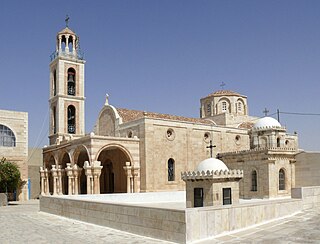
Monothelitism or monotheletism is the view that Jesus Christ has two natures but only one will. It is contrary to dyothelitism, the christological doctrine that Jesus Christ has two wills that correspond to his two natures.

Theodosius II, commonly surnamed Theodosius the Younger, or Theodosius the Calligrapher, was the Eastern Roman Emperor for most of his life, taking the throne as an infant in 402 and ruling as the Eastern Empire's sole emperor after the death of his father Arcadius in 408. He is mostly known for promulgating the Theodosian law code, and for the construction of the Theodosian Walls of Constantinople. He also presided over the outbreak of two great Christological controversies, Nestorianism and Eutychianism.
Eutyches was a presbyter and archimandrite at Constantinople. He first came to notice in 431 at the First Council of Ephesus, for his vehement opposition to the teachings of Nestorius; his condemnation of Nestorianism as heresy led him to an equally extreme, although opposite view, which precipitated his being denounced as a heretic himself.
Flavian II of Antioch was the Patriarch of Antioch from 498 until his deposition in 512.
Jacob Baradaeus, also known as Jacob bar Addai or Jacob bar Theophilus, was the Bishop of Edessa from 543/544 until his death in 578. He is venerated as a saint in the Oriental Orthodox Church and his feast day is 31 July. Jacob's missionary efforts helped establish the non-Chalcedonian Syriac Orthodox Church, also known as the "Jacobite" Church after its eponymous founder, and ensured its survival despite persecution.

Severus the Great of Antioch, also known as Severus of Gaza, was the Patriarch of Antioch, and head of the Syriac Orthodox Church, from 512 until his death in 538. He is venerated as a saint in the Oriental Orthodox Church, and his feast day is 8 February.

Peter the Iberian was a Georgian royal prince, theologian and philosopher who was a prominent figure in early Christianity and one of the founders of Christian Neoplatonism. Some have claimed that he is the author known conventionally as Pseudo-Dionysius the Areopagite.

Sophronius was the Patriarch of Jerusalem from 634 until his death. He is venerated as a saint in the Eastern Orthodox and Catholic Churches. Before rising to the primacy of the see of Jerusalem, he was a monk and theologian who was the chief protagonist for orthodox teaching in the doctrinal controversy on the essential nature of Jesus and his volitional acts.
The Second Council of Ephesus was a Christological church synod in 449 AD convened by Emperor Theodosius II under the presidency of Pope Dioscorus I of Alexandria. It was intended to be an ecumenical council, and it is accepted as such by the miaphysite churches but was rejected by the Chalcedonian dyophysites. It was explicitly repudiated by the next council, the Council of Chalcedon of 451, recognised as the fourth ecumenical council by Chalcedonian Christians, and it was named the Latrocinium or "Robber Council" by Pope Leo I. The Chalcedonian churches, particularly the Roman Catholic and Eastern Orthodox communions, continue to accept this designation, while the Oriental Orthodox repudiate it.
Patriarch Paul of Alexandria was Greek Patriarch of Alexandria between 537 and 542.
The Ecthesis is a letter published in 638 CE by the Byzantine emperor Heraclius which defined monotheletism as the official imperial form of Christianity.
Paul II, also known as Paul the Black or Paul of Alexandria,, was the Patriarch of Antioch and head of the Syriac Orthodox Church from 550 until his deposition in 575.

The Monastery of St. Theodosius, Deir Dosi and Deir Ibn Ubeid in Arabic, is the monastery founded around 476 by Saint Theodosius the Cenobiarch and contains his tomb. It is located east of the village of al-Ubeidiya, some 8 kilometres east of Bethlehem, on the road towards Mar Saba Monastery, on the West Bank, Palestine.
John Rufus, John of Beth Rufina, or John of Maiuma, was an anti-Chalcedonian priest of Antioch, a disciple of Peter the Iberian and an ecclesiastical historian who possibly served as the bishop of Maiuma. He wrote the Plerophoriae, the Life of Peter the Iberian, and the Commemoration of the Death of Theodosius.
Theodosius of Jerusalem was Patriarch of the Church of Jerusalem from 864 to 879.
The Gaianites were a Julianist faction within the Egyptian miaphysite church between the sixth and ninth centuries.
Theodosius was one of the leading Christian monks of Palestine opposed to the Council of Chalcedon (451). He was installed as bishop of Jerusalem in opposition Juvenal in 451 or 452, but was forced into exile by the emperor Marcian in 453.
This is a list of the bishops of Jerusalem before the Council of Chalcedon (451), which provoked a schism.
This page is based on this
Wikipedia article Text is available under the
CC BY-SA 4.0 license; additional terms may apply.
Images, videos and audio are available under their respective licenses.





